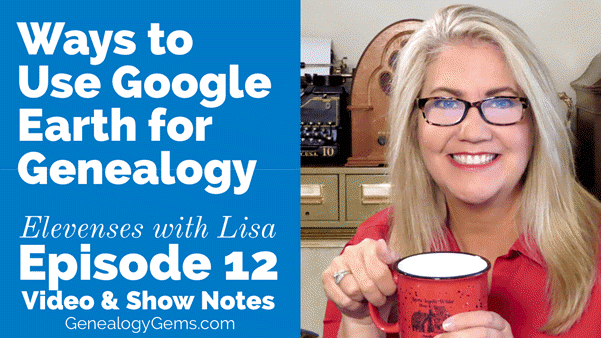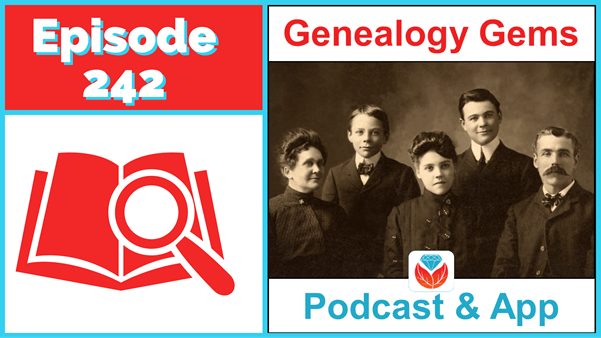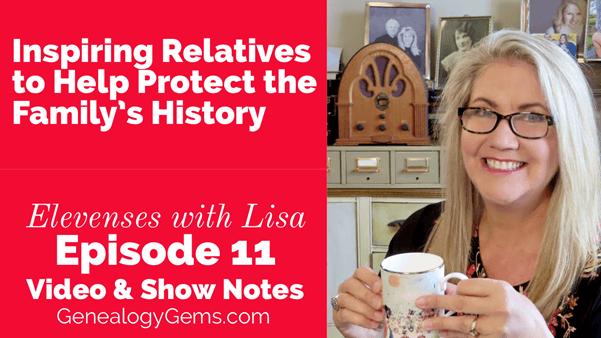by Lisa Cooke | Feb 17, 2020 | 01 What's New, Records & databases
There are a wide range of genealogical records newly available online. Here are new and updated collections as of this week. We’ve included important information about each collection that will help you determine whether it is suitable for your genealogical research. We include affiliate links for which we may be compensated, at no expense to you. Thank you for supporting free article like this by using our links.
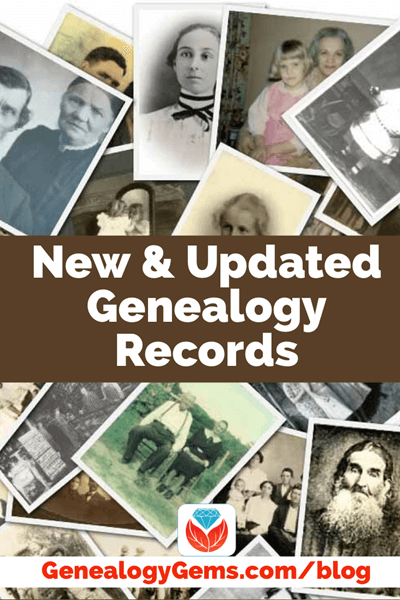
The latest genealogy records from Genealogy Gems.
NEW: HALL COUNTY NEBRASKA NEWSPAPER DIGITIZATION PROJECT
About the collection:
“The Hall County Newspaper Digitization Project is a collaborative project supported by the historical and genealogical societies, newspapers, public libraries, and museums in Hall County. This project will digitize the 28 historic newspapers published in Hall County since 1870. The Grand Island Independent (up to 1924) is included in this project.”
Newspapers included in the first completed phase of digitization include:
- Platte Valley Independent (1870-1884);
- Grand Island Times (1873-1892);
- Grand Island Independent (1884-1900);
- Wood River Gazette (1884-1892);
- Doniphan Eagle (1892-1895);
- Staats-Anzeiger und Herald (1894-1918);
- Wood River Interests (1894-1919);
- Wood River Sunbeam (1906-2003).
Search the collection here.
DIGITAL LIBRARY OF GEORGIA
Sanborn Fire Insurance Maps (Select Georgia towns and cities. 1923-1941)

Sanborn Fire Insurance Maps at the Digital Library of Georgia
About the collection:
“The Digital Library of Georgia has just made Sanborn fire insurance maps produced between 1923-1941 for 39 Georgia towns and cities in 35 counties freely available online. The maps, which are now in the public domain, can be retrieved at dlg.usg.edu/collection/dlg_sanb, and complement the DLG’s existing collection of the University of Georgia Map and Government Information Library’s 539 Sanborn maps dating from 1884-1922 that have been available since 2005. The DLG has also upgraded its image viewer, which will allow better access and improved navigation to the new and older Sanborn images from this collection.”
Search the collection here.
MYHERITAGE
Search the following collections here at MyHeritage.
NEW: New York, Birth Index, 1881-1942
About the collection:
“This collection consists of indexes of births from the state of New York between the years 1881 and 1942. The State of New York began statewide registration of births in 1881, supervised by the local board of health. A record may include the following information when it is available: given name and surname, birth date, town of birth, and gender. The images in this collection have been obtained through the outstanding work and efforts of Reclaim the Records.
This index does not contain lists of births from New York City. New York City is considered to be a separate vital records jurisdiction from the rest of New York state, and consequently the city has its own birth indices. However, a small number of New York City birth listings are found throughout this index. This is due to the births happening in towns that were previously independent before the consolidation of the city in 1898 (for example, a pre-1898 birth in a place like Canarsie [Brooklyn] or Flushing [Queens] might be listed here) or because there was a late birth registration.”
NEW: Minnesota, Death Index, 1904-2001
About this collection:
“This collection includes an index of death records from Minnesota, between 1904-2001. Information may include the deceased name, date of death, county of death, date of birth, county of birth and certificate number. It may also include the mother’s maiden name when available.
Information for the years 1908-2001 is recorded from death certificates as recorded by a physician or a mortician. Information in this collection for years prior to 1908 is taken from death cards. Unlike death certificates, many death cards were filled out very incompletely. Cards, especially for the cities of Minneapolis and St. Paul, frequently contain little more information than the name of the decedent, date of death, sex, marital status, birthplace, cause of death, and person reporting the death.”
Number of records: 4,460,579
NEW: Minnesota, Birth Index, 1900-1934
About this collection:
“This collection contains an index to birth records from Minnesota between 1900-1934. Information may include: first name, middle name, and last name of the child. It may also include the date and county of birth, certificate number. It may also include the mother’s maiden name when available.
Birth certificates were used to record birth information beginning in 1907. When a child was born, a physician or midwife compiled information about the child on a birth certificate. The certificate was registered with the local county registrar. Birth cards were used to collect birth information from 1900 to 1907. Unlike birth certificates, many birth cards were not completely filled out. 80% of this collection takes place between 1907-1937, 19% is from 1900-1907 and 1% is from before 1900.”
Number of records: 3,406,802
Updated: MyHeritage Photos and Docs
About this collection:
“This collection includes public photos, videos and documents posted by MyHeritage members on their family sites. You may contact a member who submitted a photo to get in touch or request additional information.”
Number of records: 141,129,707
ANCESTRY
U.S. City Directories, 1822-1995
About the collection: “This database is a collection of directories for U.S. cities and counties in various years. The database currently contains directories for all states except Alaska.
Generally a city directory will contain an alphabetical list of citizens, listing the names of the heads of households, their addresses, and occupational information. Sometimes a wife’s name will be listed in parentheses or italics following the husband’s. Other helpful information might include death dates for individuals who had been listed in the previous year’s directory, names of partners in firms, and forwarding addresses or post offices for people who had moved to another town.”
Search the collection here.
NEW: New York State, Address Notification and Absentee Ballot Application Cards, 1944
About the collection:
“This collection consists of notices received in 1944 by the War Ballot Commission from members of the United States Armed Forces, American Red Cross, and other service organizations serving in World War II that resided in New York requesting absentee ballots or notifying the office of a change in address. For more information on this collection, please visit the Finding Aid page on the New York State Archives site. There are two main forms present in this collection – pre-printed applications for war ballot, and postcards with change of address information.”
Information contained varies, and may include:
- soldier’s name
- soldier’s rank or rating and service number
- soldier’s birth date
- soldier’s residence at time of request
Search the collection here.
Updated: 1860 U.S. Federal Census – Slave Schedules
About the collection:
“The slave schedule was used in the following states: Alabama, Arkansas, Delaware, Florida, Georgia, Kentucky, Louisiana, Maryland, Mississippi, Missouri, New Jersey, North Carolina, South Carolina, Tennessee, Texas, Virginia.”
Search the collection here.
Updated: 1850 U.S. Federal Census – Slave Schedules
About the collection:
“The slave schedule was used in the following states: Alabama, Arkansas, Delaware, Florida, Georgia, Kentucky, Louisiana, Maryland, Mississippi, Missouri, New Jersey, North Carolina, South Carolina, Tennessee, Texas, Virginia.”
Search the collection here.
Updated: New Zealand, Cemetery Records, 1800-2007
About the collection:
“These transcriptions of headstones from cemeteries in New Zealand typically include details such as name, birth date, death date, and the cemetery name and plot location. But they may also provide family relationships with name and other details about a spouse, cause of death, military dates, an epitaph, or even a description of the headstone.”
378,207 new records were added.
Search the collection here.
Updated: U.S. Virgin Islands, Danish West Indies Slave Records, 1672-1917
About the collection:
“This database contains Danish records relating to slavery in what became the U.S. Virgin Islands.
During Danish rule, officials kept voluminous records, including the slave-related records found in this database. They include the following:
- case papers concerning contested slave ownership
- emancipation records
- registers of free men, women, and children of color
- lists of baptisms, marriages, and burials
- lists of slave owners and former slaves
- mortgages and loans
- slave lists and censuses
- records of Royal Blacks
- compensation agreements
- courts martial
The records can be a valuable source of names, dates, places, and other details. These records have not yet been indexed, but they can be browsed by record type. Most of the records are in Danish.
This collection was previously published as image only. The collection has since been indexed and this update adds 80,184 new records.”
Search the collection here.
Updated: California, Voter Registrations, 1900-1968
About the collection: “This database consists primarily of the voter indexes published every two years, including indexes to the Great Registers, to affidavits for registration, and to precinct registers.
Voter registrations were kept on the county level by the county clerk. Indexes to these records are organized according to county and voting wards and/or precincts. Within each precinct voters are listed alphabetically according to surname.”
Information may include:
- Name
- Age
- Address
- Occupation
- Political Affiliation
Search the collection here.
UNIVERSITY OF NEVADA, RENO – CITY DIRECTORIES
The University Libraries has recently digitized early city directories of Reno, Sparks, and the surrounding areas, which date from 1900.
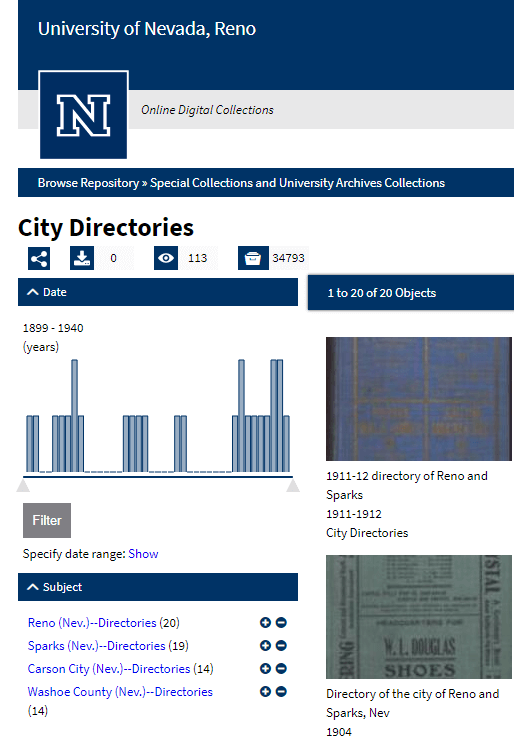
Nevada City Directories at the University of Nevada
Search the collection here.
FINDMYPAST
NEW: Canadian Directories & Almanacs
Findmypast has launched brand new collection with records from the province of Prince Edward Island. According to the company, more will be added from across Canada over the coming months.
About the collection:
“The eclectic mix of five directories cover the late 19th century from 1880 to 1899.”
The titles included are:
- Frederick’s Prince Edward Island Directory
- McMillian’s Agricultural and Nautical Almanac
- McMullan’s Almanac
- Teare’s Directory & Hand Book Of The Province of Prince Edward Island
- The Prince Edward Island Almanac
Search the collection here.
Updated: PERiodical Source Index (PERSI)
About the collection:
“Over 7,000 images have been added covering a variety of PERSI publications, perfect for fleshing out family stories. The new periodical titles that have been added are:
- Vermont Quarterly Gazetteer: A Historical Magazine / Bound With New Title: Vermont Historical Gazetteer
- Recherches Historiques
- Cambridge Historical Society Publications/proceedings
- Archivium Hibernicum / Irish Historical Records
- Queen City Heritage / Ohio Valley History
- Connecticut Historical Society Collections
Simply filter by periodical to get to the latest additions.”
Search the collection here.
by Lisa Cooke | Jan 28, 2020 | 01 What's New, Records & databases |
Once again, this week’s newest genealogical records to come online don’t disappoint. As I compiled this list for you this week, I jumped with joy as I discovered records that confirm the stories of my youth.
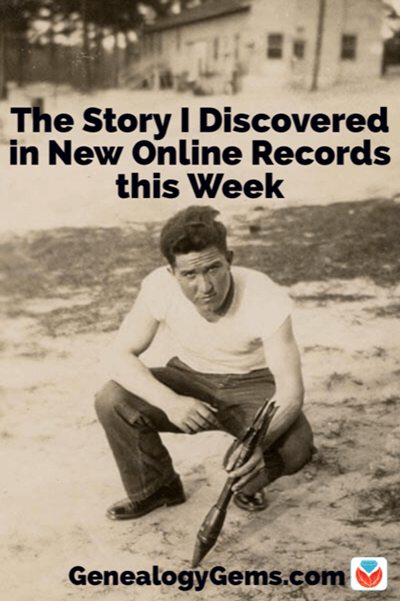
Like many families, mine is complicated. After my paternal grandparents divorced in 1956, my grandmother married her ex-husband’s brother in 1958.
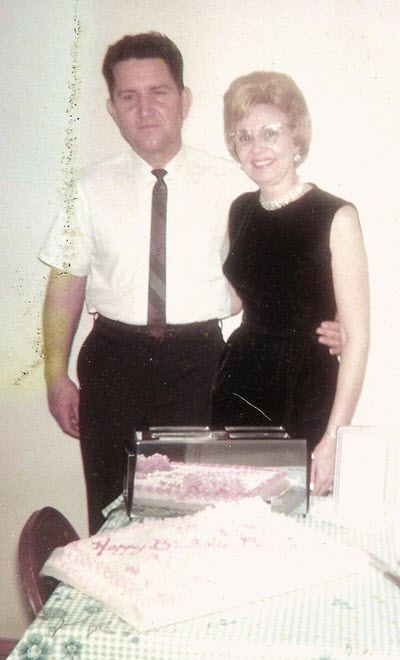
Uncle Elzie and Grandmother Pauline Moore
Elzie Moore was not only my great uncle, but my step-grandfather (if there is such a thing.) As a child all I knew was that I was lucky to have what amounted to three grandfathers, although we respectfully called him “Uncle Elzie”.
This photo very much represents how I remember him:
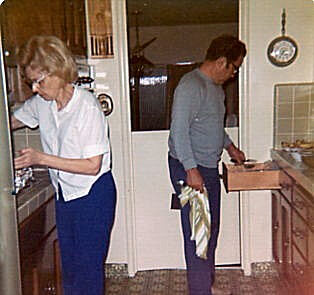
Pauline and Elzie Moore Thanksgiving 1974
He was devoted to my grandmother and ready to help whenever needed.
But well before I was born, he was ready to help his country when Pearl Harbor was attacked in 1941.
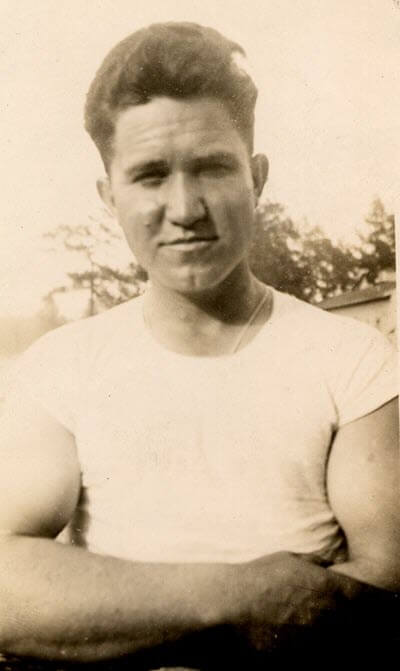
Elzie Moore in 1941.
He didn’t talk much about it, but I remember the day I was sitting on his lap examining his face. I asked him about the prominent scar on the side of his chin. He laughingly told me a variety of wild hair-brained stories as to how he got it. He then simply and quietly told me he had been shot during the war. That was that.
The story was later confirmed by my dad, who went on to explain that was just one of several wounds Uncle Elzie sustained through a heroic career.
And now, so many decades later, the details from the records themselves appear on my screen. In the WWII Hospital Admission Card Files released this month by Ancestry, I discovered not one but three different admission records.
The first was the admission record for that chin injury. He was admitted to the hospital in July of 1944 for a facial wound by a “bullet, missile” sustained in battle. He was discharged in September 1944 and sent back to the front line.
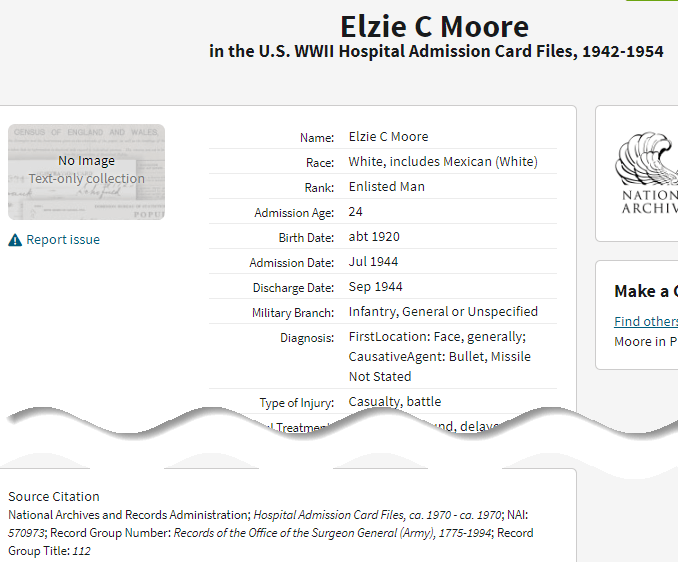
WWI Hospital Admission Records at Ancestry.com
The next record was an admission in November 1944 (although there appears to be a discrepancy in the transcription because the discharge date is listed as May 1944.) This time his injuries were shells and fragments to the thigh, buttock and hip in battle.
When working with these records it’s important to closely examine the service number listed. The third record had also matched “Elzie Moore” which you wouldn’t think was a common name. However, closer inspection revealed a different service number – he was not the same man.
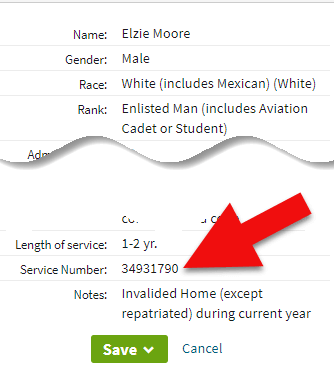
Check the service number to confirm you have the right person.
Though the man himself rarely spoke of his service, the genealogy gems I found today in the records speak volumes. I’m grateful to have more of the story behind the “Purple Heart” inscription that appears on his grave marker.
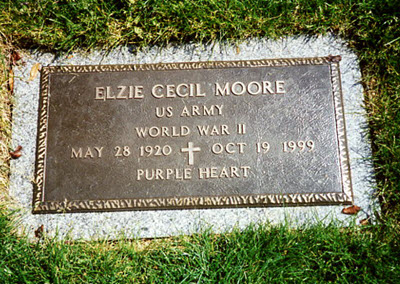
Elzie Cecil Moore grave marker
I hope this week’s list below brings you new genealogy gems!
New Records at Ancestry
Denmark
Denmark, Church Records, 1812-1918
Updated 1/15/2020
United States
U.S. WWII Hospital Admission Card Files, 1942-1954
NEW as of 1/6/2020
Washington State, U.S.
Washington, Death Index, 1940-2017
Updated 1/21/2020
New Records at FamilySearch
New Free Historical Records on FamilySearch: Week of 6 January 2020
United States
Georgia
Georgia, Chatham, Savannah, Laurel Grove Cemetery Record Keeper’s Book (colored), 1852-1942
129 Added indexed records to an existing collection
Georgia, Columbus, Linwood and Porterdale Colored Cemeteries, Interment Records, 1866-2000
114 Added indexed records to an existing collection
Hawaii
Hawaii, Board of Health, Marriage Record Indexes, 1909-1989
12,560 Added indexed records to an existing collection
Louisiana
Louisiana, New Orleans, Interment Registers, 1836-1972
868 Added indexed records to an existing collection
Louisiana, New Orleans, Slave Manifests of Coastwise Vessels, 1807-1860
115,098 New indexed records collection
Michigan
Michigan, Civil War Centennial Observance Commission, Committee on Civil War Grave Registration, Burial Records
2,957 Added indexed records to an existing collection
Mississippi
Mississippi, County Marriages, 1858-1979
2,419 Added indexed records to an existing collection
North Carolina
North Carolina, Center for Health Statistics, Vital Records Unit, County Birth Records, 1913-1922
239 Added indexed records to an existing collection
South Carolina
South Carolina, Charleston City Death Records, 1821-1926
37,437 Added indexed records to an existing collection
Tennessee
Tennessee, Shelby County, Memphis, Board of Health Death Records, 1848-1913
1,330 Added indexed records to an existing collection
Missouri
United States, Missouri, Recruitment Lists of Volunteers for the United States Colored Troops, 1863-1865
17,881 New indexed records collection
American Samoa
American Samoa, Vital Records, 1850-1972
2,237 Added indexed records to an existing collection
Australia
Australia, South Australia, Immigrants Ship Papers, 1849-1940
145,165 Added indexed records to an existing collection
Brazil
Brazil, Rio de Janeiro, Civil Registration, 1829-2012
75,768 Added indexed records to an existing collection
Brazil, Santa Catarina, Civil Registration, 1850-1999
3,314 Added indexed records to an existing collection
Canada
Nova Scotia Church Records, 1720-2001
4,881 Added indexed records to an existing collection
Chile
Chile, Catholic Church Records, 1710-1928
806 Added indexed records to an existing collection
Chile, Cemetery Records, 1821-2015
203,870 Added indexed records to an existing collection
Colombia
Colombia, Bogotá, Burial Permits, 1960-1991
6,371 Added indexed records to an existing collection
Ecuador
Ecuador, Catholic Church Records, 1565-2011
2,277,196 Added indexed records to an existing collection
England
England, Oxfordshire Parish Registers 1538-1904
43 Added indexed records to an existing collection
England, Yorkshire Marriage Bonds and Allegations, 1613-1887
1,898 Added indexed records to an existing collection
Haiti
Haiti, Port-au-Prince, Civil Registration, 1794-2012
193,434 Added indexed records to an existing collection
Ireland
Ireland, Poverty Relief Funds, 1810-1887
691,210 New indexed records collection
Italy
Italy, Trieste, Civil Registration (State Archive), 1924-1944
1,305 Added indexed records to an existing collection
Netherlands
Netherlands, Noord-Holland, Civil Registration, 1811-1950
72,937 Added indexed records to an existing collection
Peru
Peru, Áncash, Civil Registration, 1888-2005
140,119 Added indexed records to an existing collection
Peru, Ayacucho, Civil Registration, 1903-1999
3,733 Added indexed records to an existing collection
Peru, Huánuco, Civil Registration, 1889-1997
10,307 Added indexed records to an existing collection
Peru, Prelature of Yauyos-Cañete-Huarochirí, Catholic Church Records, 1665-2018
550 Added indexed records to an existing collection
Sierra Leone
Sierra Leone, Civil Births, 1802-1969
1,200 Added indexed records to an existing collection
South Africa
South Africa, Civil Marriage Records, 1840-1973
425 Added indexed records to an existing collection
South Africa, KwaZulu Natal, Vital Records, 1868-1976
4,543 Added indexed records to an existing collection
MyHeritage
Sweden
Sweden Household Examination Books, 1840-1947
Updated January 19, 2020
Total number of records in the collection: 125,672,188
“The Household Examination Books are the primary source for researching the lives of individuals and families throughout the Parishes of Sweden, from the late 1600’s until modern times. The books were created and kept by the Swedish Lutheran Church which was tasked with keeping the official records of the Swedish population until 1991.
Each book or series of books represents a 3-10 year period of time within a parish. Every year until 1894 the Parish Priest would visit each home and test each individual’s knowledge of the catechism. They would also collect information about birth dates, marriages, deaths, where people had moved to or from, etc. Each year the priest would come back and update the information of the previous year, noting changes within the population of the home. After 1894 the examinations were less focused on doctrinal knowledge and more focused on enumerating the Swedish population.”
The British Newspaper Archive
“This week we are delighted to welcome 71,598 additional pages to The Archive, as well as five brand new titles. Two of these titles, the Wakefield Express and the South Notts Echo, originate in England, while the other three, the Leinster Reporter, the Carnarvon and Denbigh Herald, and the Times of India are spread out across Ireland, Wales and India respectively.”
Start searching the British Newspaper Archive here.
New historic newspaper titles added:
Leinster Reporter
Years added: 1897-1925, 1927-1928
Caernarvon & Denbigh Herald
Years added: 1850-1872, 1874-1877, 1897
Times of India
Years added: 1861-1865, 1867-1888
Wakefield Express
Years added: 1879, 1892, 1897-1898, 1902, 1911, 1918
South Notts Echo
Years added: 1919-1923, 1927-1939
What Have You Found this Week?
Did you find some genealogy gems in any of these new records? We’d love to hear your story. Please leave a comment below.
And if you enjoyed this article we’d be grateful if you shared it on Facebook and other social media to help other family historians. You’ll find convenient sharing buttons at the top of this article. Thank you!
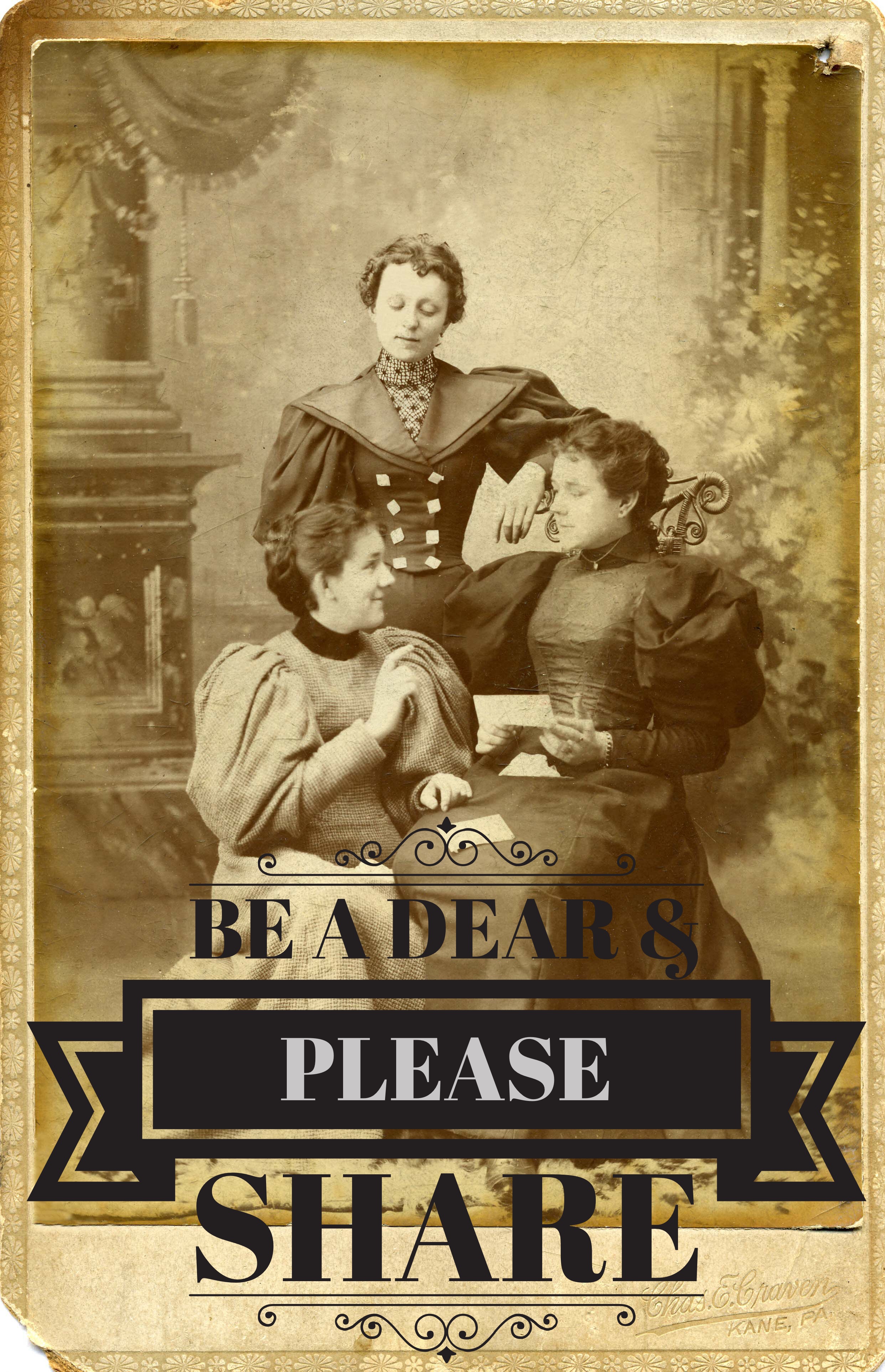
by Lisa Cooke | Dec 16, 2019 | 01 What's New, Records & databases |
Here are the important system and records updates from industry leaders. Each new feature and record offers a new opportunity to learn more about your family history. Let’s get started!
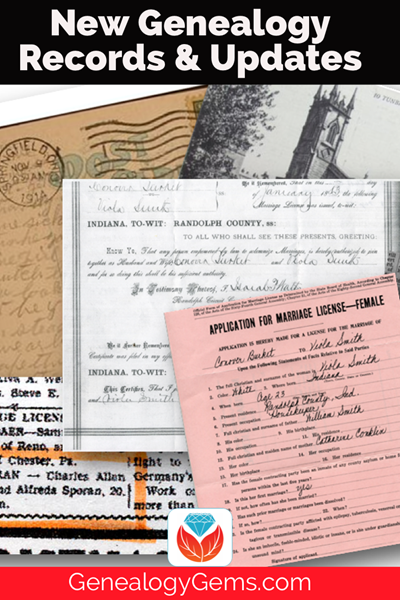
MyHeritage Updates
MyHeritage announced an update their Related Records features on December 16, 2019. Here’s the latest from their blog:
“We recently revamped Related Records in SuperSearch™ to ensure that you don’t miss any important historical records that can lead you to new discoveries.
Related Records, previously known as Record Detective™, shows additional records or family tree profiles that might belong to the person or people featured in the historical record you are currently viewing.
The technology scans the record you’ve discovered in SuperSearch™ and matches it to our entire database of over 10.2 billion historical records and family tree profiles to locate related records.
For example, a birth record could point to a newspaper article about the wedding of the same person, where you could learn about new family members that you weren’t aware of.
To make Related Records more practical and ensure that you won’t miss them, we now show them in a convenient panel on the right-hand side of the record instead of below it.
Related Records are generated by MyHeritage’s record-to-record matching technology, and we’ve just re-calculated these matches, adding hundreds of millions of additional Related Records. This will open the door to many new and exciting discoveries.”
MyHeritage Records
MyHeritage has also been busy adding new records:
Germany, War Graves Index, 1902-1961
An index of 4,234,266 records
“This index of over 4.2 million records containing information on German soldiers and civilians who died in wars or military operations between 1902 and 1961.
Many of the records are for soldiers killed during World War I or World War II. While the amount of information in each record varies, the vast majority of records contain the following searchable data: first and last name, date of birth, date of death, and place of death. Some records also include birth place, burial place, and military rank.
The burial place is seldom recorded, but when available it can provide valuable information about the location of the grave.
While this is largely an early 20th-century military death index, many women are present in this collection.
In the case of soldiers who went missing, the date of death field may refer to the date on which they went missing. Similarly, the place of death may refer to the place from which they went missing.”
Australia, Military Lists and Awards
An index of Australian military rolls.
960,081 records
United States, Index of Burials, 1900-2019
An index of records from various cemeteries located in the United States.
492,002 records
Australia, Index of Burials, 1900-2019
An index of records from various cemeteries located in Australia.
438,587 records
England & Wales, Prerogative Court of Canterbury, Index of Will Registers, 1384-1858
An index of wills proved before the Prerogative Court of Canterbury and other jurisdictions.
979,653 records
United Kingdom, Royal Navy Ratings’ Service Records, 1853-1928
An index of Royal Navy service records for ratings who entered the service between 1853 and 1928.
803,684 records
United Kingdom, Registry of Shipping and Seamen: Royal Navy Reserve Ratings’ Records of Service, 1908-1958
An index of service record cards of Royal Naval Reserves, mainly those who served during the First World War.
129,896 records
United Kingdom, Royal Air Force Officers’ Index, 1918-1919
An index of service records of those who served in the Royal Air Force (RAF) during the First World War (1914–1918).
101,411 records
United Kingdom, Royal Marines’ Service Records, 1842-1925
An index of service registers of men who joined the Royal Marines between 1842 and 1925.
112,012 records
United Kingdom, Index of Merchant Seamen’s Campaign Medals, 1939-1945
An index of 108,387 records
United Kingdom, Index of Merchant Seamen’s Campaign Medals, 1914-1918
An index of recipients of British War Medals, Mercantile Marine Medals, and Silver War Badges issued to merchant seamen and officers in the First World War.
157,424 records
United Kingdom, Recommendations for Military Honours and Awards, 1935-1990
An index of recommendations for military honors and awards between 1935 and 1990 to British Army personnel and army personnel from British dominions.
78,497 records
United Kingdom, Royal Navy Officers’ Service Records, 1756-1931
An index of service records for officers who joined the Royal Navy between 1756 and 1931.
66,686 records
United Kingdom, Royal Navy Volunteer Reserve Index, 1903-1922
An index of First World War service records for officers and ratings of the Royal Naval Volunteer Reserve (RNVR).
59,784 records
United Kingdom, Index of Death Duty Registers, 1796-1811
An index of 51,146 records
United Kingdom, Admiralty and War Office: Royal Naval Division: Records of Service, 1914-1919
An index of service records of ratings and officers in the Royal Naval Division (RND) during the First World War.
50,017 records
Click here to search for these records at MyHeritage.
FamilySearch Records
FamilySearch has also continued to add indexed records. Most are to existing collections, but some are new collections. Here’s what they announced on December 9, 2019.
SALT LAKE CITY, UT—New, free, historical records were added to FamilySearch.org from American Samoa, Brazil, Chile, Colombia, Costa Rica, England, France, Ireland, Italy, Netherlands, New Zealand, Peru, Puerto Rico, South Africa, Venezuela and the United States. Over 800,000 records were added from the Cape Province of Africa (1895-1972.)
American Samoa
American Samoa, Vital Records, 1850-1972
3,550 indexed records
Added indexed records to an existing collection
Brazil
Brazil, Santa Catarina, Civil Registration, 1850-1999
8,512 indexed records
Added indexed records to an existing collection
Chile
Chile, Catholic Church Records, 1710-1928
7,707 indexed records
Added indexed records to an existing collection
Colombia
Colombia, Bogotá, Burial Permits, 1960-1991
79,631 indexed records
Added indexed records to an existing collection
Croatia
Croatia, Delnice Deanery Catholic Church Books, 1725-1926
2,870 indexed records
Added indexed records to an existing collection
Costa Rica
Costa Rica, Civil Registration, 1823-1975
151,856 indexed records
Added indexed records to an existing collection
England
England, Herefordshire Bishop’s Transcripts, 1583-1898
599 indexed records
Added indexed records to an existing collection
England, Huntingdonshire Parish Registers
52,367 indexed records
Added indexed records to an existing collection
England, Oxfordshire Parish Registers 1538-1904
51,159 indexed records
Added indexed records to an existing collection
England, Yorkshire Marriage Bonds and Allegations, 1613-1887
2,587 indexed records
Added indexed records to an existing collection
England, Cambridge Parish Registers, 1538-1983
468,063 indexed records
Added indexed records to an existing collection
France
France, Vienne, Military Draft Cards, 1867-1921
3,633 indexed records
Added indexed records to an existing collection
Ireland
Ireland, James Alexander Henderson, The Belfast and Province of Ulster Directory for 1856
37,363 indexed records
New indexed records collection
Ireland, Thom’s Irish Almanac & Official Directory 1868
103,355 indexed records
New indexed records collection
Northern Ireland, Tithe Applotment Books, 1822-1837
175,575 indexed records
New indexed records collection
Ireland and Britain, Transatlantic Migration from North America, 1858-1870
42,695 indexed records
New indexed records collection
Ireland, Thom’s Official Directory of the United Kingdom of Great Britain and Ireland, 1894, Irish Section
121,181 indexed records
New indexed records collection
Ireland, Thom’s Official Directory, 1910
131,734 indexed records
New indexed records collection
Italy
Italy, Trieste, Civil Registration (State Archive), 1924-1944
100 indexed records
New indexed records collection
Netherlands
Netherlands, Archival Indexes, Vital Records, 1600-2000
101,765 indexed records (over several weeks)
Added indexed records to an existing collection
New Zealand
New Zealand, Archives New Zealand, Probate Records, 1843-1998
637 indexed records
Added indexed records to an existing collection
Peru
Peru, Amazonas, Civil Registration, 1935-1999
26,959 indexed records
Added indexed records to an existing collection
Peru, Ayacucho, Civil Registration, 1903-1999
1,394 indexed records
Added indexed records to an existing collection
Peru, Huánuco, Civil Registration, 1889-1997
23,227 indexed records
Added indexed records to an existing collection
Peru, Prelature of Yauyos-Cañete-Huarochirí, Catholic Church Records, 1665-2018
1,494 indexed records
Added indexed records to an existing collection
Peru, Tacna, Civil Registration, 1850-1998
193,495 indexed records
Added indexed records to an existing collection
Puerto Rico
Puerto Rico, Civil Registration, 1805-2001
714 indexed records
Added indexed records to an existing collection
South Africa
South Africa, Cape Province, Civil Deaths, 1895-1972
818,292 indexed records
Added indexed records to an existing collection
United States
Alabama
Alabama, Confederate Pension Applications, ca. 1880-1930’s
168,372 indexed records
Added indexed records to an existing collection
Alabama, County Birth Registers, 1881-1930
8,206 indexed records
Added indexed records to an existing collection
Arkansas
Arkansas Confederate Pensions, 1901-1929
96,713 indexed records
Added indexed records to an existing collection
California, San Francisco Arrivals
United States, California, List of United States Citizens Arriving at San Francisco, 1930-1949
434,995 indexed records
New indexed records collection
Georgia
Georgia, Chatham, Savannah, Laurel Grove Cemetery Record Keeper’s Book (colored), 1852-1942
24,094 indexed records
New indexed records collection
Georgia, Columbus, Linwood and Porterdale Colored Cemeteries, Interment Records, 1866-2000
28,946 indexed records
New indexed records collection
Georgia, County Delayed Birth and Death Records, 1870-1960
202 indexed records
Added indexed records to an existing collection
Hawaii
Hawaii, Board of Health, Marriage Record Indexes, 1909-1989
85,716 indexed records
Added indexed records to an existing collection
Hawaii, Hansen’s Disease Records, Kalaupapa Census Index, 1839-1970
2,336 indexed records
Added indexed records to an existing collection
Louisiana
Louisiana, New Orleans, Interment Registers, 1836-1972
133,660 indexed records
Added indexed records to an existing collection
Louisiana, Orleans Parish, Birth Records, 1819-1906
85,840 indexed records
Added indexed records to an existing collection
Louisiana, New Orleans Index to Passenger Lists, 1853-1952
151,894 indexed records
New indexed records collection
South Carolina
South Carolina, Charleston County, Charleston, Birth Registers, 1901-1926
14,132 indexed records
Added indexed records to an existing collection
Tennessee
Tennessee, Davidson County, Nashville City Cemetery Records, 1843-1962
18,187 indexed records
New indexed records collection
Tennessee, Shelby County, Memphis, Board of Health Death Records, 1848-1913
1,121 indexed records
Added indexed records to an existing collection
Texas
Texas, Harrison County Delayed Birth Records, 1860-1933
23 indexed records
Added indexed records to an existing collection
U.S. Obituaries
United States, GenealogyBank Historical Newspaper Obituaries, 1815-2011
8,829,622 indexed records
Added indexed records to an existing collection
Venezuela
Venezuela, Catholic Church Records, 1577-1995
109,788 indexed records
Added indexed records to an existing collection
FamilySearch Update
Also recently announced by FamilySearch:
FamilySearch Adds Ability to Document All Family Relationships
SALT LAKE CITY, UT (10 December 2019)
“The FamilySearch Family Tree now provides the ability for users to document all family relationships, including same-sex relationships.”
(FamilySearch) “encourages genealogical accuracy based on original source records and contains over a billion user-contributed lineage-linked records. Patrons are now able to document same-sex relationships, including same-sex marriages and same-sex adoptions.”
“When adding a spouse or parent to the FamilySearch Family Tree, the user can now add a spouse or parent of the same sex. The Family Tree mobile app will also support this new capacity after users install the necessary updates.”
Official Statement from The Church of Jesus Christ of Latter-day Saints
Ancestry Record Updates
Here are the latest new and updated historical genealogy records from Ancestry:
Updated:
Australia and New Zealand, Find A Grave Index, 1800s-Current
Updated:
U.S., Find A Grave Index, 1600s-Current
Updated:
Brazil, Find A Grave Index, 1800s-Current
New:
New York State, Card Index to Supreme Court and Court of Chancery Documents, 1648-1848
New:
Milwaukee, Wisconsin, Marriages, 1838-1911
New:
Milwaukee, Wisconsin, Births, 1839-1911
New:
Milwaukee, Wisconsin, Deaths, 1854-1911
Updated:
Norway, Find A Grave Index, 1800s-Current
Updated:
Sweden, Find A Grave Index, 1800s-Current
Updated:
Italy, Find A Grave Index, 1800s-Current
Updated:
Germany, Find A Grave Index, 1600s-Current
Updated:
Mexico, Find A Grave Index, 1800s-Current
by Lisa Cooke | Nov 17, 2019 | 01 What's New, Ancestry, Research Skills |
Browse-only collections at Ancestry and other genealogy websites are sometimes viewed as inaccessible, but they are actually a hidden treasure. Learn how to access these browse-only collections at Ancestry and expand your family history research.
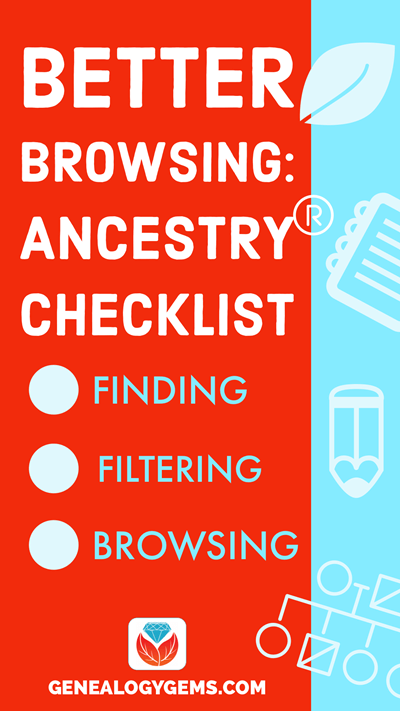
In the past we’ve written about how to access browse-only content at FamilySearch.org. Many readers said it opened a whole new world of genealogy records to them that they didn’t know they were missing.
The good news is that FamilySearch is not alone in offering browse-only content. Ancestry.com also has browse-only collections of digitized records. (Not an Ancestry.com subscriber yet? Click here to learn more. This is an affiliate link and we are compensated if you make a purchase, which supports this free blog. Thank you!)
Knowing how to search and browse records effectively is critical because you shouldn’t just rely on hints. Ancestry, for example, only provides hints from about the top 10% of their most popular databases. That means if you only spend time on reviewing hints, you’re missing a massive amount of genealogical information available in all of the other records.
Typically you’ll be using the search feature to find those other records. However not all records are searchable. That’s because after the long process of acquiring the rights to digitize and publish a genealogy record collection, it takes even longer to get them indexed for a variety of reasons. Thankfully, Ancestry doesn’t always make us wait to gain access to them until the indexing is complete.
The digital images are published without an index. This means they are not searchable by names and other keywords. Therefore, it can take some time to locate a record within one of these collections. But I think you’ll agree it’s more convenient to look through them from the comfort of your own home rather than renting microfilm or traveling to a far off location!
Here’s your checklist for better browsing.
HOW TO FIND BROWSE-ONLY RECORDS AT ANCESTRY
While Ancestry.com doesn’t make it quite as easy as FamilySearch to find browse-only or partially-indexed databases, it’s still very much worth the effort.
1. Head to the Card Catalog
From the main menu on the Ancestry website, select Search > Card Catalog.

2. Search and Filter
In the upper left corner you can search the catalog by title and / or keyword. However, if you know the type of record you are looking for, such as military records, the best place to start is filtering by that category. If the list is long, you can then search within that category by keywords.
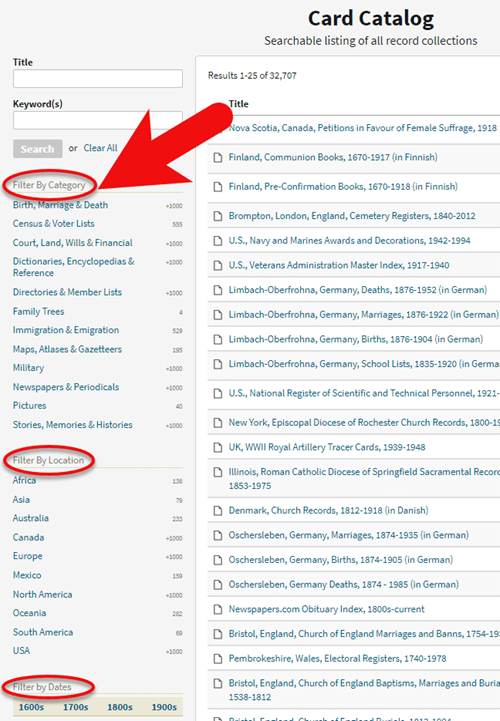
3. Determining if the Records are Searchable
If you don’t see a search box on the left side, then you can assume that this collection has not yet been indexed and therefore isn’t searchable by keywords and other data. Instead you will see typically see the source information box at the top.
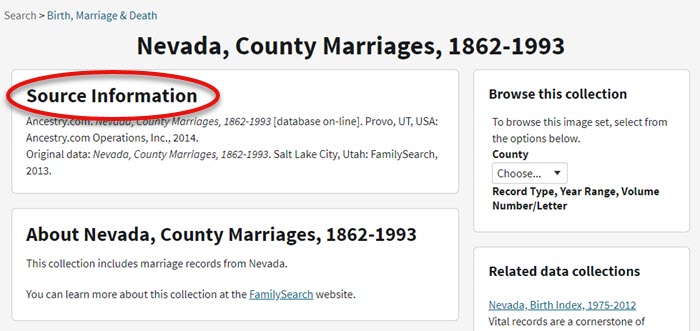
HOW TO FILTER BROWSE-ONLY GENEALOGY RECORDS
1. Browse This Collection Box
On the right side of the screen you will see a Browse this Collection box. The filtering options presented will depend on the way the collection is organized.
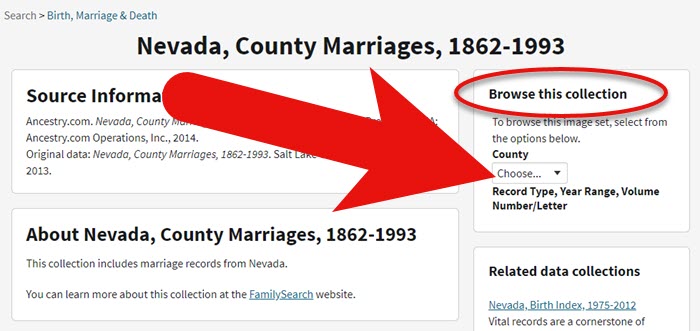
In the case of the Nevada County Marriage database, a drop down menu allows you to filter by county.
2. Make a Selection
As you can see in my example, once I selected a county I can also filter down by record books. So even though you can’t search names, you can often zero in on the portion of the collection most relevant to your search.

Browse this Collection box
HOW TO BROWSE RECORDS AT ANCESTRY.COM
Once you have selected the available filters, you’ll find yourself in the digitized records. They are displayed in a filmstrip layout which will come in quite handy for navigation through the pages.
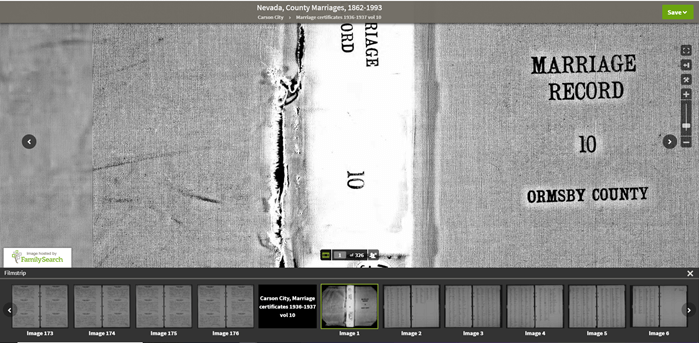
Navigation is crucial since we can’s search by names and keywords. Let’s take a closer look at the ways you can navigate:
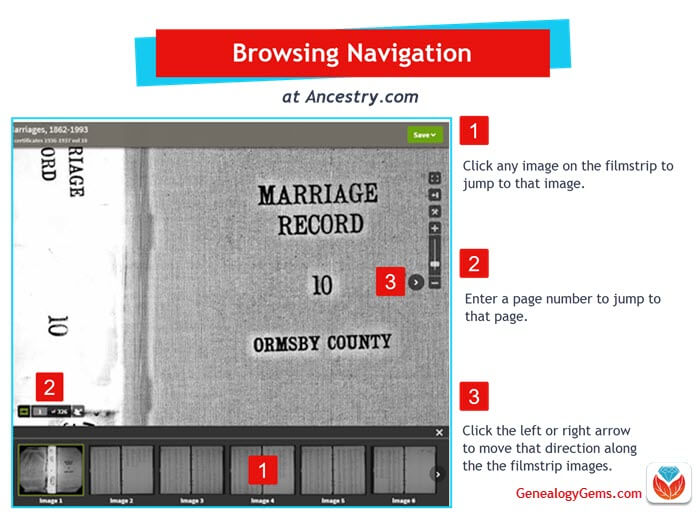
Browsing a digitized genealogy record collection at Ancestry.com
Finding the Filmstrip
if you don’t see the filmstrip view, click the filmstrip icon:
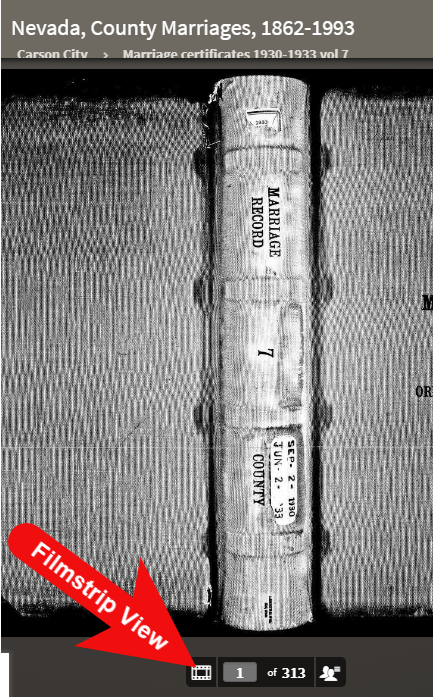
Finding and Using the Original Index
WATCH THE BONUS VIDEO below to see the next section in action. Click on the sound button to the right of the play button to turn on the sound.
Many records that were originally bound in books like this collection include index pages. In this book the index appears at the beginning. If you look closely at the filmstrip images it’s easy to spot where the index lists are and where the records begin.

So even though Ancestry hasn’t had the chance to index the records yet, they are indexed in the book. This will make the job of browsing for the records you need even easier.
The “About” box on the card catalog entry often includes important information about whether or not the collection has an index. One example of this is the Canada, Photographic Albums of Settlement, 1892-1917 record collection. It is a browse-only series of digitized photo albums by Canada’s Department of the Interior between 1892 and 1917. The collection description includes very useful instructions such as: “At the beginning of each album, you will find a table of contents with a brief description of each photograph and the photograph number. Use these tables to help you browse to the photograph of interest.” As you can see, taking a few extra moments to read about the collection can make browsing it much easier.
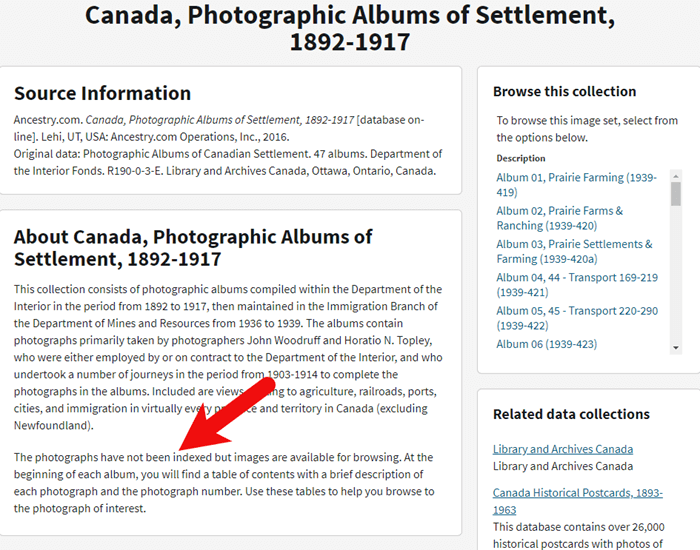
Save Time When Browsing Between Volumes
Remember that Browse this Collection box on the right hand side of the card catalog entry page? (See the Browse this Collection box image 6 images above.) This handy menu is also embedded in the record viewer. If you need to switch to a different book, album or other portion of the collection, you don’t have to hit the back button and start over. Instead, at the top of the viewing page, click the volume or collection you are currently viewing (this appears as a sub-title under the main title of the collection.) A browse structure menu will appear showing you all the other options within the collection. Just click the one you want and you will be instantly switched over. Think of it as pulling a different volume of a series of books off the shelf!
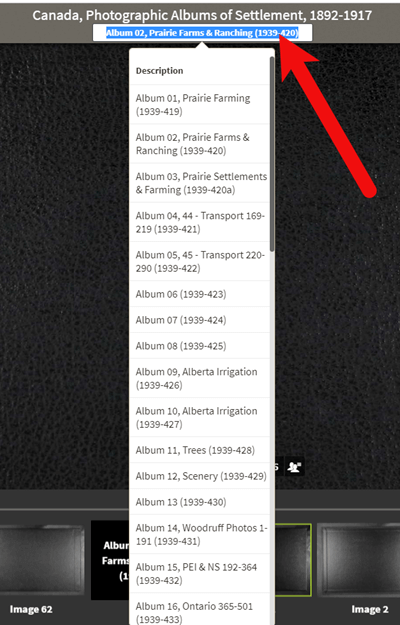
Switching volumes within the collection within the viewer.
Browsing Indexed Records
There will be times when even though a record collection is indexed, you may still want to browse it. Browsing isn’t just for unindexed records. Many genealogy gems can be found by browsing a database that you’ve already searched. You may spot neighbors of interest, other surnames from your family tree, and more. So even when you are working with a record collection that has a search box, look for the browsing option in the right column.
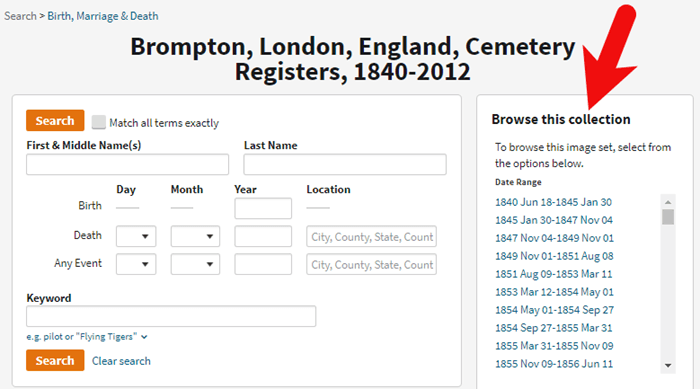
HOW TO FIND THE NEWEST RECORDS AT ANCESTRY.COM
The records most likely to not yet be indexed, and therefore browse-only, are the newest records added to Ancestry. If you’re looking to bust through a brick wall, here’s a great way to find the newest records that just might do it.
1. Go to the Card Catalog
From the main menu on the Ancestry website, select Search > Card Catalog.
2. Sort the Records
In the right hand corner you’ll find a Sort By menu. Select Date Added.
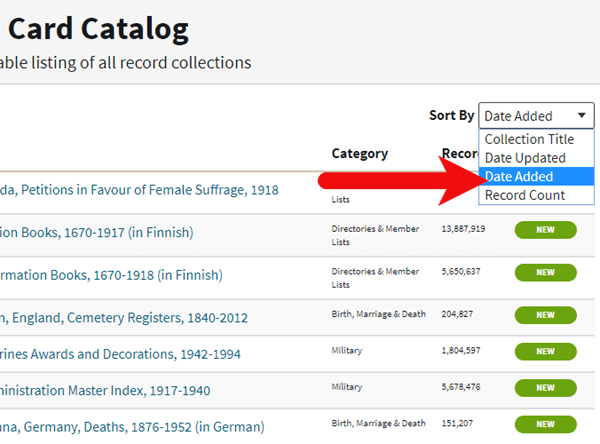
Select Date Added from the Sort by menu.
3. Newest Record View
The Card Catalog will now be presented in the order in which the records were added. The newest records will appear at the top of the list.
4. Filter the List
Use the filters along the left side of the page to filter the collections by record type, location, and date. Then use the search boxes to target keywords. This will give you results that include your keyword starting with the newest collections.
BONUS PDF AND MORE RESOURCES
Making a small investment of time in getting to know the search and browsing functions of a website can pay off big.
BONUS PDF: Click to download a handy ad-free PDF version of this article for easy reference: How to Find and Browse Unindexed Records at Ancestry
Here are three more articles and podcast episodes here at Genealogy Gems that can help you maximize your genealogy research efforts:
WHAT DID YOU UNCOVER USING THESE BROWSING STRATEGIES?
Please leave a comment below and share the genealogy gems that you uncover using these techniques. And of course if you have any questions, leave those as comments as well and I’ll reply.
by Lisa Cooke | Nov 3, 2019 | 01 What's New, Records & databases
The newest genealogy records to hit the Internet are exciting because of the wide range subjects they cover. Peruse these carefully because there just may be a genealogy gem waiting just for you!
New and Updated Free Records from FamilySearch
The newest additions to the FamilySearch collections are global in their reach, and best of all they are free. Here’s the latest:
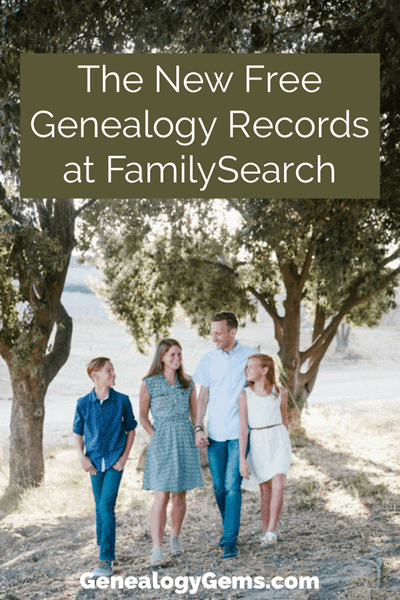
American Samoa
American Samoa, Vital Records, 1850-1972
2,874 Added indexed records to an existing collection
Argentina
Argentina, Salta, Catholic Church Records, 1634-1972
98,907 Added indexed records to an existing collection
Brazil
Brazil, Santa Catarina, Civil Registration, 1850-1999
4,072 Added indexed records to an existing collection
Canada
Manitoba Church Records, 1800-1959
58 Added indexed records to an existing collection
Chile
Chile, Catholic Church Records, 1710-1928
2,670 Added indexed records to an existing collection
Colombia
Colombia, Bogotá, Burial Permits, 1960-1991
18,221 Added indexed records to an existing collection
England
England, Oxfordshire Parish Registers 1538-1904
826 New indexed records collection
England, Yorkshire Marriage Bonds and Allegations, 1613-1887
960 New indexed records collection
England, Bedfordshire Parish Registers, 1538-1983
376,993 New indexed records collection
England, Devon Bishop’s Transcripts, 1558-1887
33,158 Added indexed records to an existing collection
England, Warwickshire, Parish Registers, 1535-1963
20,994 Added images to an existing collection
Finland
Finland, Tax Lists, 1809-1915
73,007 Added indexed records to an existing collection
France
France, Vienne, Census, 1876
20,638 Added indexed records to an existing collection
Peru
Peru, Cemetery Records, 1912-2013
565 Added indexed records to an existing collection
Peru, Huánuco, Civil Registration, 1889-1997
6,480 Added indexed records to an existing collection
Peru, Junín, Civil Registration, 1881-2005
365 Added indexed records to an existing collection
Peru, Prelature of Yauyos-Cañete-Huarochirí, Catholic Church Records, 1665-2018
680 New indexed records collection
United States
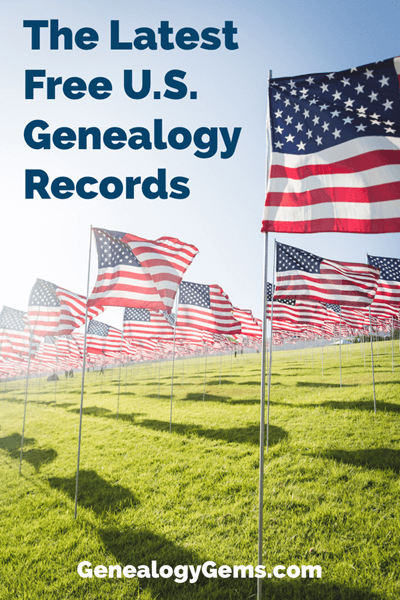 Alabama Deaths, 1908-1974
Alabama Deaths, 1908-1974
697 Added indexed records to an existing collection
Alabama, County Birth Registers, 1881-1930
6,638 Added indexed records to an existing collection
Alabama, Friends of Magnolia Cemetery, Funeral Books, 1911-1965
6,606 Added indexed records to an existing collection
California, Lassen County, State Board of Health, Burial Permits, 1931-1988
800 Added indexed records to an existing collection
Georgia, County Delayed Birth and Death Records, 1870-1960
7687 Added indexed records to an existing collection
Hawaii, Board of Health, Marriage Record Indexes, 1909-1989
10,729 Added indexed records to an existing collection
Illinois, Stark County Circuit Court, Stark County Naturalization Records
560 New indexed records collection
Louisiana, New Orleans, Interment Registers, 1836-1972
12,755 Added indexed records to an existing collection
Louisiana, Orleans Parish, Birth Records, 1819-1906
30,826 Added indexed records to an existing collection
Mississippi, Adams County, Natchez Death Index, 1835-1905
168 Added indexed records to an existing collection
Missouri, County Marriage, Naturalization, and Court Records, 1800-1991
5,678 Added indexed records to an existing collection
Nebraska, Grand Army of the Republic, Burial Records, 1861-1948
364 Added indexed records to an existing collection
North Carolina, Wake County, Death Records, 1900-1909
2,537 Added indexed records to an existing collection
South Carolina, Charleston County, Charleston, Birth Registers, 1901-1926
601 Added indexed records to an existing collection
Tennessee, Board of Health, Shelby County, Memphis Death Records, 1848-1913
1,061 New indexed records collection
Texas, Harrison County Delayed Birth Records, 1860-1933
196 Added indexed records to an existing collection
United States, GenealogyBank Historical Newspaper Obituaries, 1815-2011
98,269 Added indexed records to an existing collection
United States, Iowa Naturalization Records, 1859-1990
55,114 New indexed records collection
United States, Louisiana, Passenger Departures from New Orleans, 1867-1871
5,123 New indexed records collection
United States Census (Slave Schedule), 1860
4,429,408 Added indexed records to an existing collection
Virginia, Slave Birth Index, 1853-1866
13,135 Added indexed records to an existing collection
Wisconsin, Milwaukee, Pilgrim’s Rest Cemetery, Interment Records, 1880-1979
300 Added indexed records to an existing collection
Wales, Anglesey, Parish Registers, 1538-1912
281,418 Added indexed records and images to an existing collection
The Latest from Ancestry.com
Obituaries are a staple of genealogical research. Here’s the latest from the folks at Ancestry:
“Ancestry® updated its collection of US obituaries by combing through millions of digital obituaries to key names, relationships and other facts so members can now easily search these records with just one click.
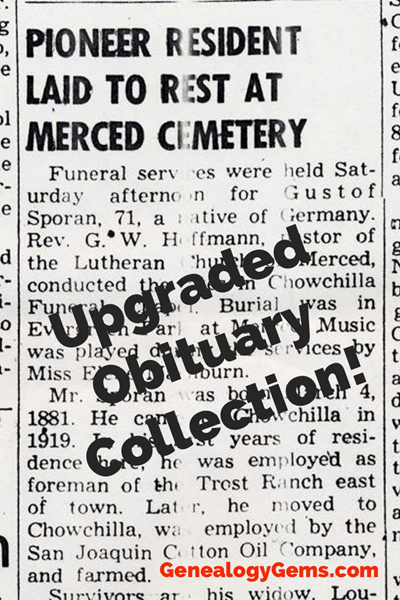
This initiative first announced at RootsTech uses new sophisticated artificial intelligence technology.
The new Newspapers.com Obituary Collection and the upgraded Ancestry U.S. Obituary Collection will expand Ancestry’s unparalleled historical record collections that enable people around the world to uncover their family history, spark their own journey of discovery and inspire meaningful conversations.
- Obituary collections include over 262 million worldwide obituaries and death announcements with almost 1 billionsearchable family members
- US Obituary Collection, 1930-Current search is the world’s largest, searchable digital archive, now includes 4x more searchable family members
- Newspapers.com Obituary Index includes facts from nearly 200 millionNewspapers.com obituaries
- Newspapers.com is the largest online newspaper archive, with over 525+ million pages of historical newspapers, including obituaries, from thousands of printed newspapers across the United States and beyond.
Members with an Ancestry All Access or Newspapers.com Basic subscription have a 1-click option to view the full obituary on Newspapers.com. Some images may require a Publisher Extra subscription as certain newspapers require additional licenses to view their content.”
Visit Ancestry here.
Visit Newspaper.com here.
Other Unique Collections Updated
From the State Archives of North Carolina blog comes a very interesting addition ton an existing Civil War digital collection:
A selection of 12 volumes from the Soldiers’ Home Association have been added to the Civil War digital collection. These volumes document the history of medical care for veterans and the elderly around the turn of the 19th century.”
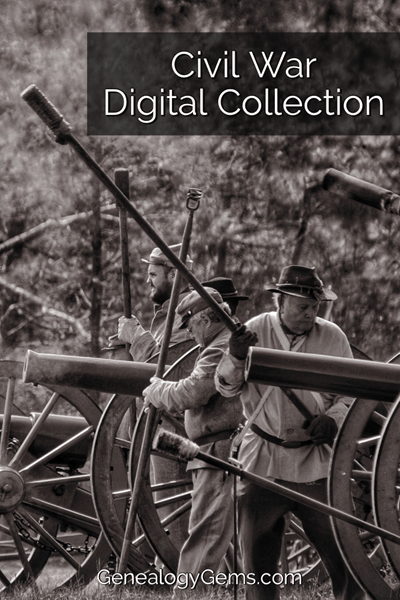
“These volumes provide recorded information on veterans’ military service, illnesses or injuries that might not have been recorded elsewhere. Some volumes include patients’ requests for their burial and funeral wishes. The volumes included are listed below:
Roll Book, 1890-1911
Register, 1890-1917
Record of Inmates, 1896-1924
Record of Inmates, 1925-1936
Record of Clothing Issued, 1926-1934
Hospital Patients, 1908-1916
Hospital Register, 1911-1919
Hospital Register, 1925-1930
Hospital Night Orders, 1918-1919
Hospital Night Orders, 1919
Hospital Night Orders, 1924
Hospital Night Orders, 1928-1929″
New British Genealogy Records
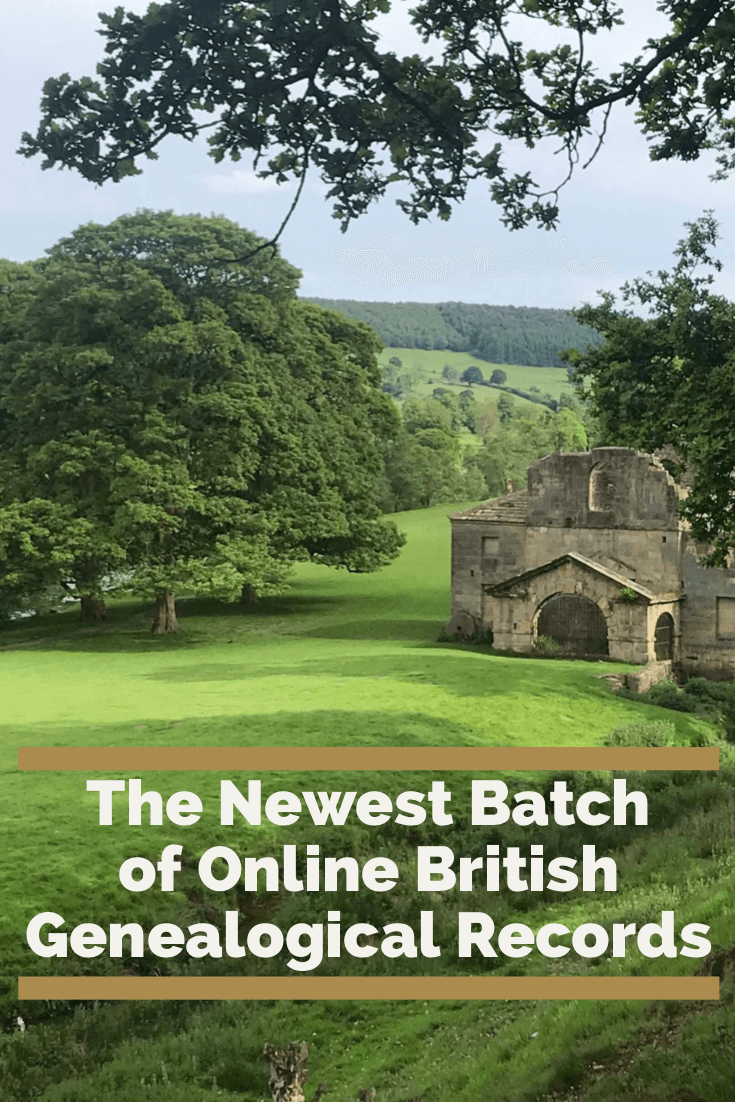
1801 Census
Discover your Scouse ancestor’s address, occupation and who they were living with in 1801. Findmypast now offers over 13,000 new and exclusive early census records. Don’t miss the images because they provide additional information about your ancestor’s abode.
The 1801 census was the first official census to be carried out in Britain. It estimated the population of England and Wales to be 8.9 million, and that of Scotland to be 1.6 million.
The 1801 census comprised two parts:
- the first was related to the number of people, their occupations, and numbers of families and houses.
- The second was a collection of the numbers of baptisms, marriages and burials, thus providing an indication of the rate at which the population was increasing or decreasing.
Click the following link to search the collection: 1801 Lancashire, Liverpool Census
Cornwall Burials
Over 75,000 new records covering 52 parishes across the Cornish peninsula are now available to search at Findmypast.
These transcripts reveal 5 key pieces of information:
- when your ancestor was buried
- where your ancestor was buried
- their age at death,
- residence
- and relatives’ names.
Click here to search the Cornwall Burials collection.
Kent Burials
And finally, Findmypast has added 12,000 new records to their collection last week. The majority of these new additions cover Swanscombe municipal cemetery and will reveal where and when your ancestor was buried as well as the names of their spouse and father. Click here to search the Kent Burial records.
New Records Coming Soon
Recently announced on the University of Georgia website:
“Through a new partnership with Google, about 120,000 of the Libraries’ 4.5 million volumes will be digitized, allowing further access to literary, historic, scientific and reference books and journals through UGA’s library catalog as well as one of the largest digital book collections in the world.”

“In addition to more modern materials that will be available for preview online, other examples of volumes available in full text include shipping registers from as far back as 1764 and Atlanta city directories dating back to 1870.
The project also advances a longstanding effort to provide digital access to state and federal government publications, and free digital access will be available to works by Balzac, Sir Francis Bacon, Robert Louis Stevenson, Thomas Hardy and other historically significant authors, thanks to UGA Libraries.”
Read the full post here.
What Did You Discover this Week?
Did one of these new and updated digital genealogy collections deliver what you’ve been waiting for? Please share your discovering in the Comments below. And click here to subscribe to the free Genealogy Gems newsletter to receive all the latest in new and updated genealogy records for your family history.
Page 1 of 712345...»Last »


































